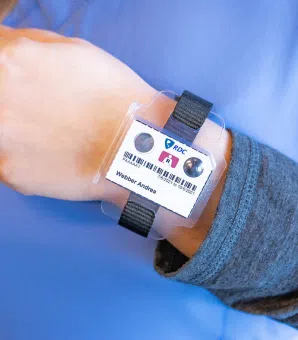
Dosimeter badge services for medical, dental, and veterinary businesses
Learn how Radiation Detection Company’s easy-to-use dosimetry solutions can boost the efficiency of your practice.

There are a multitude of radiation dosimeters on the market these days. Which makes it increasingly important that you do your research to find out what your organization truly needs. From a whole-body dosimeter vs. a ring dosimeter, and a TLD vs. OSL dosimeter, there are many decisions to be made. In this article, we take a closer look at the factors that need to be considered before ordering dosimeters.
As always, we hope you find this article informative, and we look forward to hearing your feedback!
To understand your organization's needs, you should consult your Radiation Safety Office or Committee. A Radiation Safety Committee (RSC) is a vital part of the radiation safety program for any business that interacts with radioactive material.
A Radiation Safety Committee generally consists of a Radiation Safety Officer (RSO), a management representative, and personnel who work with radiation-producing devices or are otherwise at risk of occupational exposure.
The RSC is ultimately the governing body for all aspects of radiation protection in the workplace. Your Radiation Safety Committee will make assessments based on your workplace and the needs of the organization in conjunction with local, state, and federal requirements.
Two of the most important variables when considering which dosimeter is right for your organization is the industry your organization operates, and the functionality needed.
For example, a nuclear plant will have different needs than a medical facility. A medical facility will have different needs than an industrial application. Dosimeters are also chosen based on the type(s) of radiation present in the workplace, and the radiation levels. Another important factor is NVLAP accreditation for the radiation type that the dosimeter is measuring. The dosimeter needs to be appropriate for the radiation work environment. For example, if photons and neutrons are present, you wouldn’t want to only wear a dosimeter that was only accredited for photons.

The U.S. Nuclear Regulatory Commission (NRC) has established and maintains a dose limit for occupational exposure for people working with radioactive materials. States regulate X-rays and X-ray generating devices to also be in compliance. These limits function as a form of radiation protection for monitoring personnel.
People in contact with radioactive materials or x-ray generating devices during the course of their employment (or those who may be exposed to radiation) normally carry personal dosimeters to measure radiation emitted during their work. These dosimeters are specifically designed to record and indicate the radiation dose received.
Absorbed dose is generally the most important measure for radiation personnel. Absorbed dose is the measure of the radiation energy deposited in matter by ionizing radiation per unit mass. Absorbed dose is a measurable quantity and a key component of radiation protection as well as radiology.
There are two types of dosimeters: active and passive. A passive dosimeter doesn't need an external source of energy to operate, and is known as an integrating dosimeter. Meaning it only gives an estimate of a cumulative dose. Personal dosimeters are a crucial component of passive dosimetry.
Passive dosimeters record how much radiation an individual is exposed to over a specific period of time (whether it be a month, quarter, or year) - known as accumulated dose. These badges are collected and analyzed after the fact. After each wear period, a new badge is issued and used, and the old one is collected to analyze occupational dose.

Passive dosimeters are preferred in hospital settings and other locations where personnel are frequently exposed to low levels of radiation. These dosimeters are considered “passive” because they do not need to be monitored continuously.
Active dosimeters, on the other hand, measure instantaneous doses, provide a visual indication which can alert attention to possible exposure, and follow the variations of radiation exposure over time. These dosimeters - like an electronic personal dosimeter (EPD) - provide a real-time direct display of information about the measured dose for the individual wearing the device. Electronic dosimeters play a major role in active dosimetry.
Radiation Detection Company is dedicated to your safety and the safety of all of your employees. We have 75 years of experience providing quality radiation dosimetry solutions to over 31,000 companies worldwide.
To see which of RDC’s radiation safety products are right for your department or organization, please visit our Solutions page to view our full suite of offerings. We offer a wide range of affordable and comprehensive solutions to fit the needs of both large and small organizations.
Have a question that we did not address in this article? Please reach out to our Customer Care team, and one of our specialists will be happy to support you.
Learn how Radiation Detection Company’s easy-to-use dosimetry solutions can boost the efficiency of your practice.